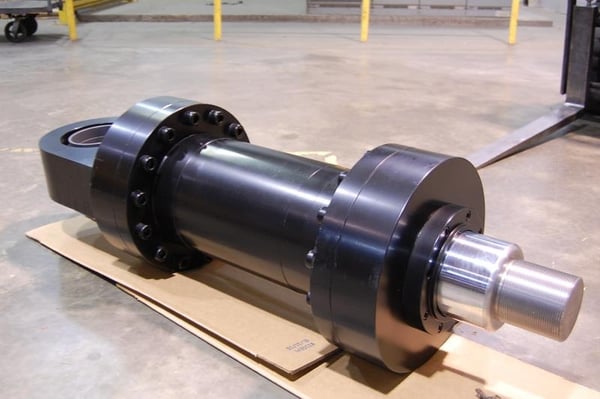
There are several different types and designs of hydraulic cylinder to consider for your application. Each has unique advantages and is best suited to certain types of application. In this article we take a brief look at the main types of hydraulic cylinder.
Most types of hydraulic cylinders fall into the categories of single acting or double acting cylinders. Some applications may also require telescopic cylinders or tandem cylinders
1) Single Acting Cylinders
In a single acting hydraulic cylinder piston force is applied in a single direction. The working stroke is pushed outward as the cylinder contracts at the head end – hence the alternative name of ‘push cylinder’. As the force flows only one way the return stroke is dependent on an internal spring mechanism around the piston shaft, or an external motor.
2) Double Acting Cylinder
Double acting hydraulic cylinders can exert force in two directions. The piston cylinder is divided into two pressurised chambers that enable the rod to achieve both outward and return strokes under its own power. Mechanical energy is transferred to the piston surface through a special type of hydraulic fluid.
There are several types of double acting cylinder:
a) The standard double acting cylinder has a single piston shaft and exerts force in one direction. They are used in applications for opening and closing doors, or for raising arms etc.
b) Non-differential, or Double Rod cylinders have two rods, one attached to each side of the piston surface. The outward stroke for one rod equals the return stroke of its opposite number. By alternating the pressure in the two piston chambers, the hydraulic cylinder can exert an oscillating back/forth motion.
c) Balanced hydraulic cylinders have two equal compression chambers that exert the same force in both directions, as opposed to unbalanced hydraulic cylinders, which have chambers of different sizes/pressure potential.
d) Cushioned hydraulic cylinders include a limiting device at the piston head of the cylinder to reduce excess load at the end of the outward stroke.
Double acting hydraulic cylinders are simple and cheap to manufacture and are extremely versatile. They are widely used in construction plant, manufacturing equipment and vehicles.
3) Tandem Hydraulic Cylinders
Tandem hydraulic cylinders are two separate cylinder barrels, connected by a single rod linked to a piston head in each barrel. When the first cylinder is pressurised, the rod enters the base end of the attached cylinder and pushes the piston surface, amplifying and transmitting the force. Using tandem cylinders allows amplification of the force available from small cylinders. It also conserves energy within a system as outward pushing force is only required in the first cylinder. Most tandem cylinders are of the double acting type, with the return stroke made possible by pressurising the piston end chamber of the outermost attached cylinder. Sometimes three or more cylinders can be connected in tandem stages.
4) Telescopic/Multistage/Ram type/Actuating Hydraulic Cylinders
Telescopic cylinders are a number of individual cylinders nested together in order of decreasing size. Anything up to six stages are common. The cylinder barrel itself acts as the piston rod, transferring force to the next cylinder in a similar way to a tandem cylinder. Telescopic cylinders are widely used in long reach equipment, such as crane lifts and digger arms. Most telescopic hydraulic cylinders are single acting, utilising a spring mechanism for the return stroke.
Choose The Right Kind Of Cylinder For Your Application
At Ranger Caradoc we manufacture a wide range of hydraulic components for all applications, including many types of cylinder. Our standard product catalogue includes thousands of components permanently kept in stock in our warehouse in the UK. We can also custom design cylinders and other components to your specifications. For more information, please call 01299 896953. You may also want to download our Buyer’s Guide To Hydraulic Cylinders – a free e-book you can access by clicking here.






